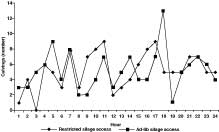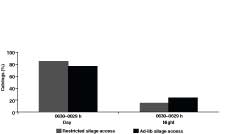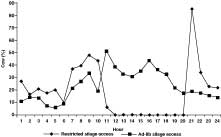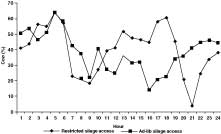|
The INTERNATIONAL JOURNAL of APPLIED RESEARCH In Veterinary Medicine |
 |
| Current Issue |
| Previous Issues |
| Reprint Information |
| Back to The International Journal of Applied Research in Veterinary Medicine |
Effect of Silage Feeding
Regimen on Time of Calving and Behavior in Holstein-Friesian Cows
David E. Gleeson, Dip in Dairy Husbandry, MSc
Bernadette O’ Brien, B BSc, Dy, MSc, PhD
Kevin O’ Donovan, BAgrSc
John F. Mee, MVB, PhD, MRCVS
Teagasc, Dairy Production Research Centre, Moorepark,
Fermoy, County Cork, Ireland
KEY WORDS: Dairy cows, calving times, feeding times, behavior
Abstract
Two grass silage-feeding
regimens were imposed on housed spring-calving cows on three research
farms. Cows on treatment 1 had access to the silage between 2030 hours
and 1030 hours. Cows on treatment 2 had continuous access to silage
over a 24-hour period. Cows remained on their respective feeding regimens
until calving (mean days on treatment, 45). Daytime and nighttime calvings
were defined as calvings that occurred from 0630 to 0029 and from 0030
to 0629, respectively. Cow behavioral patterns were studied using three
24-hour observations conducted on one of the research farms. Restricting
silage feeding time to between 2030 and 1030 hours resulted in 9% less
night calvings (P < .08) compared with cows with full access to
silage. An even distribution of calving occurred when cows had continuous
access to silage, but calvings were not evenly distributed when silage-feeding
time was restricted. No adverse effects were detected on cows or calves.
Cow bodyweight, parity, days on treatment, and calf birth weight did
not have any influence on time of calving. A reduction in the time that
cows spent eating and more agonistic behavior were observed with cows
on a restricted silage regimen.
Introduction
In the Irish grass-based
milk production system, the majority of cows calve during a 12-week
period. This can create a severe demand on limited labor resources,
and it consequently can result in inadequate supervision at calving.
This can, in turn, lead to an increased risk of dystocia and associated
disorders such as retained placenta, infections of the reproductive
tract, poor fertility, and milk fever.1 The high labor demand associated
with the calving period may be reduced, and monitoring of calvings would
be facilitated, if some management practices could be applied that would
minimize the incidence of calving at night. The practice of feeding
cows by night is considered by many farmers to inhibit night-time calving.
A recent Irish farm labor survey indicated that approximately 50% of
dairy farmers with large herds (> 70 cows) practiced evening feeding
of silage to reduce the number of night calvings.2 Thus, anecdotal evidence
suggests that calving time may be influenced by feeding time. The physiologic
mechanisms by which night feeding might reduce the incidence of night-time
calvings are unknown. However, rumen motility studies have indicated
that the frequency of rumen contractions decreases during the hours
immediately before calving. Thus, rumen contractions associated with
feeding may influence calving time.
Results of previous studies on the effect of feeding time on calving time are inconsistent. Clarke et al.3 reported that feeding of Holstein cows at 1730 hours compared with 0800 hours increased daylight calvings (72% vs 55%). The percentage of beef calves delivered between 0600 and 2200 hours was also shown to increase from 57% to 77% when cows were fed at 2200 hours compared with 0900 hours.4 Eighty percent of beef cows fed between 2100 and 2200 hours calved during the day compared with 20.4% at night.5 These results suggest that feeding at 2200 hours may be the optimum time to achieve the most calves born during daylight hours. However, Pennington et al.6 found that approximately 68% of beef cows calved during daylight irrespective of feeding time. In agreement, MacMillan et al.7 showed that altering feeding time of dairy cows from 0700 to 1600 or 1900 did not increase the frequency of daylight calvings. Although the grass consumed by the cows in these studies before the main feed allocation was deemed negligible, it may have influenced the result.
The amount of artificial lighting in the calving area
may influence time of calving.8 Researchers have shown that cows eat
more when exposed to long-day photo-periods.9 The additional intake
may influence the subsequent time of calving. The absence of control
cows in some studies and the opportunity for at least some grazing may
explain the lack of consistency in these results.
The objective of this study was to establish the effect of feeding regimen on time of calving for spring-calving dairy cows housed indoors on a silage diet. Behavior patterns associated with the different feeding regimens were also recorded.
Materials and Methods
Experimental Design
Two grass silage-feeding regimens were imposed on spring-calving pregnant Holstein-Friesian cows on three research farms for a period of 12 weeks. Cows were accommodated in cubicle housing on mats and sawdust, with access to a silage-feeding barrier. One hundred and thirty eight, 74, and 38 cows on research farms 1, 2 and 3, respectively, were paired on the basis of expected calving date and parity group (1, 2, and ³ 3). Cows from each pair were assigned at random to one of two feeding treatments on each farm. The treatments were (1) access to the silage feed face between 2030 and 1030 hours of each 24 hour period, and (2) continuous access to the silage feed face over a 24-hour period. All treatment practices were replicated on the three farms. Daytime and night-time calvings were defined as calvings that occurred between 0630 and 0029 hours and between 0030 and 0629 hours, respectively.
Access to silage was controlled by removing the silage from the feed face or by presence of an electric tape across the feed face. Adequate headspace was available to allow all cows within the treatment groups to feed at the same time. Cows with an expected calving date within 10 days of the trial commencement date were not assigned to treatment. Cows remained on their respective feeding treatments until time of calving (mean ± SD 21 days on treatment = 45), including the period while in the calving area, that is directly before calving. Drinking water was available to cows at all times, and one cubicle space per cow was allowed. Both groups had grass-silage delivered to the feed passage daily at 1030 hours. Chemical analysis of a composite silage sample was performed weekly, and the dry matter (DM) intake per cow was calculated based on the DM analysis of the silage. Cows were offered silage of 731-g/kg dry matter digestibility with a crude protein content of 135 g/kg.
Measurements
Hourly calving supervision was practiced. Assistance at calving was recorded using a scoring system of 1 = no assistance, 2 = slight difficulty, 3 = serious difficulty, 4 = very serious difficulty, and 5 = caesarean section. During the study period, darkness occurred between 1730 and 0730 hours, during which time artificial lighting was used to facilitate calving supervision. The time of calving was recorded as when the calf was fully emerged from the vagina, either unassisted or assisted by farm staff. When the calving was not observed, the time of calving was estimated from the time of the last visit and based on the mobility and dryness of the calf. Calf mortality was recorded at birth, and multiple births were excluded from the data set. All cows were pregnant to dairy sires. The incidence of retained placenta and cows treated for milk fever was also recorded. Cows were weighed and body condition score (BCS) was recorded on a scale of 1 to 5 at the time of allocation to treatment and within 1 week after calving. A BCS of one described an extremely thin cow, and a score of 5 described an extremely fat cow. Mean cow weight loss per day was calculated as the difference between the cow bodyweight when assigned to treatment and the post-calving cow bodyweight. Calf weight was recorded within 12 hours of birth. Silage intake was measured on research farm 1 by weighing the total quantity of silage offered and refused for each treatment group, on 2 days per week over a 7-week period.
Behavioral Observations
Behavioral patterns of 26 and 21 in-calf cows from treatments 1 and 2, respectively, were recorded on research farm 1 over three 24-hour periods during week 10. The number of cows eating silage, lying down, ruminating, grooming, and standing in cubicles and engaged in agonistic behavior (aggressive activity toward one another) was recorded at 30-minute intervals. Three recorders each performed observations over an 8-hour period.
Statistical Analysis
The number of cows calved by day or night, number of assisted calvings, and the number of dead calves were analyzed using a chi-square test. Analysis of variance was used to analyze cow bodyweight, weight loss, cow condition score, gestation length, and calf weight data. Data on cow behavior were adjusted to an hourly basis, and the 3 days were pooled for statistical analysis. A Mann-Whitney U (Wilcoxon Rank-Sum) test was used to analysis the percentage of cows eating, lying, ruminating, grooming, engaged in agonistic behavior, and standing in cubicles.
Results
Restricting silage
feeding time to between 2030 and 1030 hours resulted in 9% fewer calvings
(P < .08)
at night compared with unrestricted silage access (Table 1). The frequency
of calving per hour for both restricted and unrestricted silage feeding
regimens is shown in Figure 1. Calving pattern for cows on the restricted
silage-feeding regimen was not evenly distributed between daytime and
night-time hours, with 5.9 and 3.2 calvings per hour, respectively.
Calving incidence peaked at 1100 and 1700 hours, with 9 and 9 calvings
per hour, respectively, for cows on the restricted silage feeding system.
These times represented a period after silage access was denied in the
morning and after the evening milking. The period of least calving activity
occurred at 0100 and 0300 hours, with 0 and 1 calvings per hour, respectively.
Calving frequency for cows on the unrestricted silage-feeding regimen
was evenly distributed between day and night-time hours. Cows on the
unrestricted feeding system had 5.3 and 5.0, day and night calvings
per hour, respectively. Peak calving occurred at 0500 hours during the
night period and at 1800 hours after the evening milking, with 9 and
13 calvings per hour, respectively. Fifteen percent of cows calved by
night and 85% by day when silage feeding time was restricted and 24%
calved by night and 76% by day when cows had continuous access to silage
(Fig. 2).
Feeding regimen had no effect on gestation length or calving assistance score. The grand mean gestation length was 283 days (SE, 7.5) and 14% of cows had an assistance score of more than 2 in both treatment groups. The incidence of retained placenta (2.0%) and milk fever (1.6%) did not differ between treatment groups.
There was no difference in bodyweight for calves born during daytime hours (42.6 kg) as compared with calves born during night-time hours (42.8 kg). Calf mortality (4%) did not differ for treatments 1 and 2, respectively. Cow parity or calf gender did not influence the percentage of calves born by day. Seventy-nine and seventy seven percent of cows in parities £ 2 and > 3, respectively, calved by day (P > .05). Fifty one percent and 49% of the calves born by day were male and female, respectively (P > .05). The number of days that cows were on the restricted silage-feeding regimen before calving did not affect the time of calving. Cows on the restricted feeding system for less than 20 (n = 16), 21 to 40 (n = 36), and more than 40 days (n = 64) produced 81%, 75%, and 88% of calvings during daytime hours, respectively (P < .24).
Mean bodyweights of cows on treatments 1 and 2 were 658 and 666 kg at the commencement of the study. Mean daily weight loss per cow (SE, 1.2) and condition score after calving did not differ between treatment groups. Cow bodyweight after calving was not related to time of calving. The mean daily dry matter (DM) intake of cows on treatments 1 and 2 was 10.1 (SD, 1.5) and 10.7 kg (SD, 1.6) respectively. This marginal reduction in DM intake (0.6 kg/day) with treatment 1 had no effect on cow bodyweight after calving, cow condition score, or calf weight. Cows on the unrestricted feeding regimen spent a greater proportion (P < .05) of the 24-hour period eating silage than cows with restricted access to silage (Fig. 3). Cows on the restricted feeding regime required a period of approximately 30 minutes, after silage access became available, for all cows to feed at one time. The proportion of cows lying down, standing in cubicles, ruminating, and grooming was not different between treatment groups (Fig. 4). However, cows with restricted access to silage tended to show more (P < .06) aggressive behavior than cows with continuous feed access.
Discussion
Restricting access to grass silage to between 2030 and 1030 hours precalving tended to reduce the number of cows calving at night. No adverse effects were detected on cows or calves. A previous study with beef cows using similarly defined ‘day’ and ‘night’ times and feeding times resulted in 22% fewer cows calving by night.4 However, 23% of the beef cows still calved at night whereas just 15% of the dairy cows still calved by night in the current study. The type and breed of cow together with management practices on beef and dairy farms may influence time of calving and the impact of feeding on time of calving. An investigation of 2,434 calving records showed that the frequency of night calving was higher among first parity cows compared with older cows.10 However, a further study indicated that age of dam did not affect calving time.11 A similar result was found in this study, with an equal percentage of young and old cows calving by day. It has also been suggested that time of calving can be influenced by date of calving, with a greater tendency for cows to calve by day, later in the season.10 Extending the number of days that cows were on a restricted silage-feeding regimen from less than 20 to more than 40 days did not affect the subsequent time of calving.
Researchers have suggested that lighter cows may have a higher frequency of calving by day.10 However, the mean post calving weight in the current study was similar for cows calving by day and by night. Tharmaraj et al.12 concluded that the heaviest calves are most likely to be born during the night. In this study, no difference was seen in bodyweight for calves born during daytime hours as compared with calves born during night-time hours. Edwards13 recorded time of parturition for cows with continuous access to silage and found that calving was evenly distributed throughout the 24 hours with no bias toward day or night. A lower incidence of calving during milking hours was recorded as cows passed the calving shed on their way to the milking parlor.12 Similarly, the incidence of calving reported here decreased during the milking period (1530–1700 hours) and peaked in the quiet period after evening milking. In this study an even distribution of calving occurred when cows had continuous access to silage, but calving was not evenly distributed when silage feeding time was restricted. Cow bodyweight, parity, days on restricted feed regimen and calf weight did not appear to have any influence on time of calving.
Where cows had continuous access to silage, a similar percentage of cows calved during daytime hours on farm 1 and 2; however, all cows on farm 3 calved during the daytime period. There was no explanation for the higher than expected number of daytime calvings on farm 3. The more aggressive behavior shown by cows on the restricted feed regimen was probably because of the long period without access to the silage face and competition for headspace when access became available.
The results from this trial suggest that the distribution of calving for spring calving Holstein cows between day and night may be adjusted by time of feeding. Alterations to daily management routines to allow dry cows access to silage during the night and not during the day would appear to be worthwhile in limiting the number of calvings by night.
Acknowledgments
The authors gratefully acknowledge the assistance of the farm managers John P Murphy, Aidan Lawless, and John Connolly in the conduct of this study.
References
1. Stevenson JS, Call EP: Reproductive disorders in the periparturient dairy cow. J Dairy Sci 71:2572, 1988.
2. O’Brien B, O’Donovan K, Gleeson D, et al: Profiling the working year on Irish dairy farms: Identification of some work areas towards improvement in efficiency. Irish Grass Ass J 35:128–140, 2001.
3. Clarke AK, Spearow AC, Owens MJ: Relationship of feeding time to time of parturition for dry Holstein cows. J Dairy Sci 66(suppl 1):138, 1983.
4. Stevenson JS: Relationship among climatological variables and hourly distribution of calvings in Holstein fed during the late afternoon. J Dairy Sci 72:2712–2717, 1989.
5. Yarney TA, Rahnefeld GW, Knoefal AC, et al: Time of day of parturition in beef cows. Can J An Sci 59(Abstr):836,1979.
6. Pennington JA, Albright JL: Effect of feeding time, behaviour and environmental factors on the time of calving in dairy cattle. J Dairy Sci 68:2746–2750, 1985.
7. MacMillan KL, Pearse MG, Copeman PJA, et al: Effects of varying feeding time on diurnal calving patterns in dairy cows. Proc N Z Society of Anim Prod 45:35–37, 1985.
8. Evans NM, Hacker RR: The chronobiological manipulation of time of calving and behaviour of dairy cattle. Can J Anim Sci 69:857–863, 1989.
9. Tucker HA, Petitclerc D, Zinn SA: The influence of photoperiod on body weight gain, body composition, nutrient intake and hormone secretion. J Anim Sci 59:1610–1620, 1984.
10. Makarechian M: Factors influencing time of parturition in range beef cattle. Can Vet J 25:450–452, 1984.
11. Yarney TA, Rahnefeld GW, Parker R J, Palmer WM: Hourly distribution of time of parturition in beef cows. Can J Anim Sci 62:597–605, 1982.
12. Tharmaraj J, Shinde Y, Kashiwamura F, et al: The influence of sex and birth weight of the calf and the parity and length of gestation on the time of calving. Can J Anim Sci 69:871–875, 1989.
13. Edwards SA: The timing of parturition in dairy
cattle. J Agric Sci 93:359–363, 1979.
Table 1.
Effect of Feeding Regimen* on the Number
of Cows Calving During Night-time Hours Together With Calving Details
Restricted silage access
Ad-lib silage access
(n=125) (n=125) SED P value
Night calvings† (% of cows) 17 26 – 0.08
Cow weight post-calving (kg) 578.8 591.3 9.40 0.15
Cow weight-loss (kg/day) 2.24 2.19 0.15 0.74
Cow BCS score at calving 3.29 3.21 0.06 0.14
Gestation (days) 283.1 283.4 0.67 0.59
Assistance score (% >2) 14.4 14.5 – 0.97
Calf mortality (%) 4.8 4.0 – 0.76
Calf weight (kg) 42.8 42.8 0.96 0.99
*Restricted silage access; ad-lib silage access.
†0030
to 0629 hours.
Figure 1. Frequency of calving per hour for two
feeding regimens (restricted silage access; ad-lib silage access).

Figure 2. Effect of feeding regimen
(restricted silage access; ad-lib silage access) on the percentage of
calvings by day and by night.

Figure 3. Percentage of cows eating on an hourly
basis.

Figure 4. Percentage of cows lying
on an hourly basis.

ISSN# 1542-2666